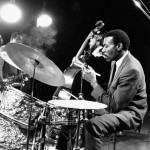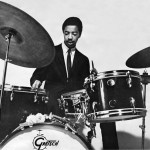After working on beat tracking for whole performances, our conversation turned to how to think about the chief rhythmic instrument in a conventional jazz group. The drummer states the tempo for the group. He also varies it in subtle but important ways, and plays contrasting figures against it. This holds for early jazz and fusion jazz and everything in between. It is part of the rhythmic expression and dynamism that is central to jazz (and many other types of music). This level of rhythmic variation is also a challenge for MIR: it may confuse the effort to establish an overall metric for performance tempos, and also generate complex patterns that could be difficult to identify reliably.
We proposed that if we could compare different drummers with different approaches to timing and tempo, we could begin to sharpen our understanding of these musical features as they relate to MIR. We would select drummers who may tend to play “ahead” or else “behind” the beat. I mentioned Tony Williams and Elvin Jones, respectively, as having these contrasting approaches to timekeeping and rhythm. Orientation toward the beat is an important point of discussion among musicians negotiating how to play together. It is also a factor in our current discussion of how an individual local event or section of a performance deviated from the average tempo in our beat-tracking work. Investigating them should help refine the beat tracking tools we have. It can help profile artists or ensembles by rhythmic style. And it might even help in the more strictly musicological aim of uncovering the techniques that serve expression, and providing demonstrable evidence for, or against, interpretative and evaluative musical terms in jazz.
We agreed, however, that we have to define more closely what we mean by a musical event or performance being ahead or behind the beat, and whether there are other phenomena involved outside of strict matters of tempo that need to be distinguished and defined separately as part of the analysis. What follows makes a tentative step toward such definitions and remarks on the difficulties in reaching them.
I assume that, as part of Brian’s work on feature extraction, we will be able to distinguish and measure what the drummer, or his cymbal in particular, is playing with respect to the tempo. Drummers play very regular patterns as part of their role of keeping time. Even if they vary their figures, they state a pulse as part of their standard “ride” pattern. I assume also that if deviations from the average beat can be measured, the deviations of a certain instrument, like the cymbal, can be as well.
Based on that groundwork, what does it mean to play something ahead of the beat, whether in one single instance, or to do so as a marker of “style”? The word implies positive but subjective qualities like having energy, pushing the group forward (precisely in the face of the potential chaos or entropy in group improvisation). But the conventional usage it is poorly defined. “Ahead” yes, but of what?
I already implied that it could mean playing ahead of an average beat for the performance. But then there may or may not be issues of measurement error there when the tempo itself may be changing—or when it is precisely the drums whose statement of the tempo we are relying on determine the average tempo. Ahead of other performers? It is plausible that a percussive event could take place before some other musical one by a different instrument. But to say that at some given time one instrument plays “ahead” of another implies reference to some established tempo against which both can be measured, leading us back to the question of how tempo is established in the first place. Our beat-trackers do this fairly effectively for short term variations from the average tempo. But do we have a way to “view” or reference that grid for the short samples we will be starting with? Perhaps we can find a valid way to establish tempo that is tailored to such a short experimental segment.
Given that we can establish such references to an underlying beat, a reservation I (and DAn) still have about speaking of a given event or percussive stroke as being “ahead” is that may not actually being ahead of anything. There are presumably volumes written about what an “accent” is and how it “should” be played. But it seems to me that it is possible that accenting some note may create the impression of being ahead of some other instrument or tempo when it is not actually so—just as shading in black and white creates the illusion of color. To strike something a little harder in one note in a series may seem to give it more “energy” (as it does to the overall performance). It may actually have more energy, in the sense that the change is measurable in amplitude and perhaps frequency of overtones. Yet on the other hand to strike something harder may actually require or occur with a relatively earlier attack, confusing the issue further. In my work on Lucky Thompson’s style of accents, I assumed that accenting a note gave at least the impression of its being slightly ahead of other notes in the series, and of the overall rhythmic pulse, and then simply noted where I thought the accents were in a transcribed solo. (Shull, “When Backward Comes Out Ahead,” Annual Review of Jazz Studies 2003).
These issues in determining what is ahead of the beat may have their mirror image in what figures or events might be “behind” the beat. Is it bad to be “behind” something? Not in jazz or African-American music in general. Being “laid back”: it implies being soulful as opposed to aggressive; it means allowing space for the soloist to develop his or her ideas; and it suggests a sense of “holding back” or suspense that is an ingredient of storytelling.
But once again, we have to ask: behind what? The question of the frame of reference holds in this case as well as that of figures or performances that are ahead. Can a drummer be consistently behind the beat and keep from losing the tempo or momentum altogether? Or is it possible that, like the subjective feeling of being ahead, being behind is another kind of artistic illusionism?
I say this because when I listen to drummers who at face value seem to have this quality, I do not necessarily hear they are striking the instrument, say a cymbal, any later than might be expected by the overall tempo, the other instruments, or relative to what other drummers are doing. They may strike the cymbal more or less on the beat—but they allow it to sustain longer. This may be an effect of the choice of cymbal or stick, and of many other factors. The point is that the sense of a statement of pulse being “relaxed” or “behind” is really “broader” rather than actually “later.” In fact, I believe this sostenuto (sustained) effect creates the impression of ease in the work of many singers, whether jazz or not, who thus get a supple feeling without seeming to lose or float entirely outside the beat. I certainly hear it in Elvin Jones, as opposed to Tony Williams, both of whom I have been listening to in trying to articulate these concepts.
If the timbre or sonic qualities of a timekeeping beat by these two influential drummers can create these necessary illusions, so can their more sophisticated rhythmic combinations or figures. Identifying and comparing such figures may be far in the future for us, so I will briefly suggest how more complex patterns may come into play. Williams often states quarter note quintuplets in his accompanying “comments” on the soloist’s ideas, while keeping or implying the beat. That is not implying a faster rate; it is actually moving faster. In contrast, Jones tends to use quarter note triplets, or more properly displaced grouping of eighth note triplets, which seem to slow down the rate and energy of the steady stream of eighth notes generated by and expected of the soloist (at least in bebop and progressive jazz). The two drummers’ overall approaches to stating the tempo, in other words, are reinforced by their rhythmic figures and the way they subdivide the time signature.
In addition to questions of timing and relation to an underlying tempo, we have a great deal of work ahead of us on the tonal qualities of percussion instruments in jazz. As with any instrument, we confront not just timbre, but modulation of timbre, even within a given single abstract “note.” Perhaps even something as granular as a single “attack” might have to be segmented or studied further at a micro level before we can proceed further on these questions of timing and duration. This will be tough to define and measure, but I mention it because it might help profile different artists’ characteristic timbres or “sounds.” With regard to percussion instruments, it does seem that prospects are good for being able to separate them from other instruments, based on Brian’s latest work.
Rather than trying to tackle the complex phenomena that might comprise a single attack, it might be simpler to identify the precise onset of a given percussion event, in a certain recording, perhaps a single part of a drum kit (for which Brian has developed codebooks I believe, or for closely related parts of a drum set). We would also want to be able to ask what this duration of this event is after this onset. To begin, this might be chosen from a small segment of a single performance.
As a next step, we could ask how these timings, or patterns of them, relate to an average beat, and compare that to other events within or across performances. Then I believe we could confidently state that event X (onset or final decay) happened at time (A) within a tempo continuum. Of course we would need to define and implement the average beat or tempo in a satisfactory way in order to reliably track what individual instruments are doing in relation to it.
If these concepts were adequately defined, we might then examine one drummer or compare two of them. We could also apply what we learned to non-percussion instruments: Improvising soloists, too, have characteristic orientations toward “the beat.” If these tools were available, even far in the future, we could not only profile a given drummer, but get a more direct look at how they interact rhythmically with other musicians, or at how polyrhythmic practices create their expressive effects, with reference to hard evidence at a micro level.


